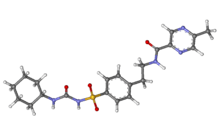Glipizide
Glipizide, sold under the trade name Glucotrol among others, is an anti-diabetic medication of the sulfonylurea class used to treat type 2 diabetes.[1] It is used together with a diabetic diet.[1] It is not indicated for use by itself in type 1 diabetes.[1] It is taken by mouth.[1] Effects generally begin within half an hour and can last for up to a day.[1]
 | |
 | |
| Clinical data | |
|---|---|
| Trade names | Glucotrol, others |
| AHFS/Drugs.com | Monograph |
| MedlinePlus | a684060 |
| Pregnancy category | |
| Routes of administration | By mouth |
| Drug class | Sulfonylurea |
| ATC code | |
| Legal status | |
| Legal status | |
| Pharmacokinetic data | |
| Bioavailability | 100% (regular formulation) 90% (extended release) |
| Protein binding | 98 to 99% |
| Metabolism | Liver hydroxylation |
| Elimination half-life | 2 to 5 hours |
| Excretion | Kidney and fecal |
| Identifiers | |
IUPAC name
| |
| CAS Number | |
| PubChem CID | |
| IUPHAR/BPS | |
| DrugBank | |
| ChemSpider | |
| UNII | |
| KEGG | |
| ChEBI | |
| ChEMBL | |
| CompTox Dashboard (EPA) | |
| ECHA InfoCard | 100.044.919 |
| Chemical and physical data | |
| Formula | C21H27N5O4S |
| Molar mass | 445.536 g/mol g·mol−1 |
| 3D model (JSmol) | |
| Melting point | 208 to 209 °C (406 to 408 °F) |
SMILES
| |
InChI
| |
| | |
Common side effects include nausea, diarrhea, low blood sugar, and headache.[1] Other side effects include sleepiness, skin rash, and shakiness.[2] The dose may need to be adjusted in those with liver or kidney disease.[1] Use during pregnancy or breastfeeding is not recommended.[2] It works by stimulating the pancreas to release insulin and increases tissue sensitivity to insulin.[1]
Glipizide was approved for medical use in the United States in 1984.[1] It is available as a generic medication.[1] In the United States the wholesale cost per dose is less than 0.05 USD as of 2018.[3] In the United Kingdom it costs the NHS less than 0.05 pounds per dose as of 2018.[2] In 2016 it was the 44th most prescribed medication in the United States with more than 17 million prescriptions.[4]
Mechanism of action
Glipizide sensitizes the beta cells of pancreatic islets of Langerhans insulin response, meaning that more insulin is released in response to glucose than would be without glipizide ingestion.[5] Glipizide acts by partially blocking potassium channels among beta cells of pancreatic islets of Langerhans. By blocking potassium channels, the cell depolarizes, which results in the opening of voltage-gated calcium channels. The resulting calcium influx encourages insulin release from beta cells.[6]
History
It was patented in 1969 and approved for medical use in 1971.[7] Glipizide was approved for medical use in the United States in 1984.[1]
See also
References
- "Glipizide Monograph for Professionals". Drugs.com. AHFS. Retrieved 24 December 2018.
- British national formulary : BNF 76 (76 ed.). Pharmaceutical Press. 2018. p. 693. ISBN 9780857113382.
- "NADAC as of 2018-12-19". Centers for Medicare and Medicaid Services. Retrieved 22 December 2018.
- "The Top 300 of 2019". clincalc.com. Retrieved 22 December 2018.
- Drugs@FDA (the official database of FDA-approved drugs) https://www.accessdata.fda.gov/drugsatfda_docs/label/2011/020329s025lbl.pdf
- LH Bösenberg & DG van Zyl (2008) The mechanism of action of oral antidiabetic drugs: A review of recent literature, Journal of Endocrinology, Metabolism and Diabetes of South Africa, 13:3, 80-88, DOI: 10.1080/22201009.2008.1087217
- Fischer, Jnos; Ganellin, C. Robin (2006). Analogue-based Drug Discovery. John Wiley & Sons. p. 449. ISBN 9783527607495.